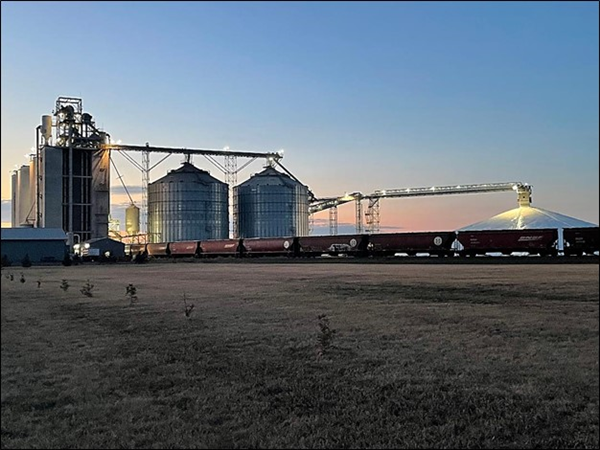By John Sandbakken*
 Photo credit: Don Lilleboe
Photo credit: Don Lilleboe
I know I’ll sound like a broken record, but from the looks of it, 2026 will again be another challenging year in terms of marketing commodities. Margins will be tighter, so producers are going to have to be engaged and watch their marketing in the year ahead.
You will also have to sharpen your pencil when it comes to figuring the bottom line, as crops that were profitable last year may not be in 2026. It likewise will be important to watch the markets carefully to take advantage of market rallies when busy selling old crop and locking in new-crop prices.
Normally when I write this story, I have access to the latest USDA data for current crop yields and production for oil and confection sunflower. As you know, the federal government shutdown made that impossible as of this early November writing. The USDA was scheduled to release the first sunflower production estimate in their October supply and demand report, but that report was not released due to the government shutdown.
It was largely expected that USDA’s sunflower yield estimate would imply record or near-record yields. In June, the USDA had forecast a 48% increase in oil sunflower planted acres and an 8% decline in nonoil sunflower planted acres. Total planted acres were pegged at 998,000.
According to the September USDA Farm Service Agency crop acreage report, area planted to sunflower in 2025 increased 78% from 2024 and totaled 1,280,125 acres. The planted area of oil-type varieties, at 1,181,580 acres, is up 99% from 2024. Planted acreage of nonoil varieties, estimated at 98,545 acres, is down 16% from last year.
Initial estimates using FSA figures and trend yields has total oil and nonoil sunflower production in a range of 2.2-2.3 billion pounds, which is about 96% higher than last year’s crop.
Traders are hopeful that USDA will release its final acreage and production estimates in January.
In its September sunflower seed stocks report, USDA pegged old-crop sunflower stocks in all positions as of September 1, 2025, at 209 million pounds, down 63% from a year ago. All stocks stored on farms totaled 21.1 million pounds, and off-farm stocks totaled 187.8 million pounds. Stocks of oil-type sunflower seed were 170.6 million pounds; of that total, 15.4 million pounds were on-farm stocks, and 155.2 million pounds were off-farm stocks. Nonoil sunflower stocks totaled 38.4 million pounds, with 5.9 million pounds stored on the farm and 32.5 million pounds stored off the farm. Stocks of oil-type sunflower seed were 66% lower than last year and in line with trade expectations. Nonoil stocks were down 44% from last year and also in line with industry estimates.
The most interesting item in the report was the change to the March 1 off farm stocks figure for oil-type seed. USDA “found” an additional 75 million pounds since the report was released. This helps explain the increased crush and birdfood usage when most thought the bins were almost empty.
Prospects Dim for 2025/26 Global Sunflower Production
Per Germany-based Oil World, global sunflower production is estimated at 57.6 million metric tons (MMT), reflecting a recovery of only 2.1 MMT from last year’s low level. Back in June, initial production estimates were in the range of 60-61 MMT.
Sunflower seed production is turning out sharply below earlier expectations, primarily in the Black Sea region. Oil World made downward revisions for Russia, Ukraine and some European Union member countries due to reports about considerably lower-than-expected yields per hectare.
Harvesting started late and was still running sizably behind last year in Russia and Ukraine. Sunflower production in the European Union is not coming up to expectations, either. Harvest was not complete, but yield reports resulted in Oil World reducing its production estimate to only 8.58 MMT, the smallest in nine years and even down slightly from last year’s drought-reduced 8.68 MMT. Heat and dryness curbed yields and production for the second consecutive year.
The estimate for Argentina’s sunflower seed crop is currently at 5.4 MMT for early 2026. A sharp increase since summer in export quotes for sunflower seed and oil reflects the tighter global market situation. Given the location of the crop losses, this bears watching as international trade would assume much of the impact and could open some opportunities for U.S. exports.
 Photo credit: Don Lilleboe
Photo credit: Don Lilleboe
Should You Plant NuSun or High-Oleic ’Flowers in 2026?
Last year, a change took place at the crush plants regarding the seeds they will crush. Crush plants are offering new-crop contracts for high-oleic seeds, but not NuSun.
The NuSun era opened many opportunities in U.S. and Canadian markets. However, the market has shifted as buyers want oils that have high amounts of monounsaturated fats and saturated fat levels at or below 7%. High-oleic sun oil fits the bill in that regard.
High-oleic sun oil has been around since the mid-1980s, though for several years its production was restricted to just one company due to patent issues. That limited oil availability, and it was mostly sold into high-end niche markets. Today, most hybrid seed companies offer high-oleic hybrids.
“We have been growing high-oleic sunflower for years with no yield drag and great oil content,” says Josh Greff, NSA vice president and Regent, N.D., grower. “As sunflower producers, we need to deliver the products our customers want, and there is increasing market demand for high-oleic oils.”
The outlook for sunflower oil continues to be bright, thanks in part to the U.S. Food and Drug Administration’s qualified health claim for high-oleic oil and its heart health benefits, as well as the FDA’s ban on partially hydrogenated oils in the United States. Several new domestic customers have come on-board adding sunflower oil to their product mix. Export markets such as Canada and Mexico have potential to grow as well, giving several market options to sell oil. There will still be a market for NuSun seeds, but it will be mainly restricted to the birdfood market.
What About Confection Sunflower for 2026?
According to USDA figures, confection sunflower has been one of the highest return-per-acre options available in this growing region since 2010. That trend is expected to continue this year as well. If you are going to take advantage of the profit opportunity producing confection sunflower offers, you should be selecting hybrids based on the percentage of large seed and percentage kernel fill they will produce.
Seed size is generally evaluated as percentage over a ‘___/64th’ round hole screen, comparing 16, 18, 20 and 22, the four most common sizes. “The export market is requiring the longer seed, so variety selection is important when planning confection sunflower production”, states Mike Kotzbacher, senior vice president of Fargo, N.D.-based Red River Commodities. “Processors are buying more on seed size, so the larger the percentage of seed over a 22/64 round hole screen, the better.”
Confection acres were at reduced levels in 2025, but this is expected to change in 2026. It is highly unlikely that there will be much of a seed carryover going into next fall’s harvest, and that will lead to a resurgence in contracted acres. Processors will want to keep the seed pipeline full to meet anticipated domestic and export market demand. Thus, the need for confection acres is expected to be strong in 2026.
Act of God or Cash Contract?
If you would like to sleep a little better at night during the growing season, consider contracting sunflower with an Act of God (AOG) production clause. Confection and oil sunflower contracts offer AOG clauses.
The AOG clause basically means the producer doesn’t have a production risk. Should drought, hail, insects, disease, etc., result in a yield loss and you don’t have enough production per acre to cover your sale, the AOG clause kicks in. You are only obligated to deliver what you produced, not what you contracted.
These ‘fail safe’ contracts have become very popular with farmers throughout the production region. It provides an opportunity to ‘lock in’ attractive prices now for fall delivery. It removes that all-important factor of ‘price risk’ in these very volatile times.
As of this early November writing, crushers are offering 2026 new-crop cash high oleic contracts at around $22.70-$22.80 per cwt. with Act of God (AOG) contracts at $22.20-$23.00. Something else to consider is the oil premiums that crush plants pay on sunflower. Sunflower is the only oilseed that pays premiums for oil content above 40%. Considering oil premiums that are offered at the crush plants on oil content above 40% at a rate of 2% price premium for each 1% of oil above 40% pushes a contract with 45% oil content gross return 10% higher per cwt. The AOG $22.20 contract increases to $24.40, and the cash $22.80 contract moves up to $25.10.
With harvest wrapped up in the Northern Hemisphere, traders’ attention will turn to the Southern Hemisphere. There are thoughts that oilseed production numbers for South America might be too high based on the developing La Nina. If any major weather damage occurs to South American crops, it will be very bullish for new-crop values in the U.S.
If you haven’t considered growing sunflower for a few years, take another look, and you’ll be surprised how this crop’s genetics have changed. As you prepare your crop budgets for this coming year, sunflower might be your most profitable crop in 2026. To talk to confection and oil sunflower buyers about contracting opportunities check out this link: www.sunflowernsa.com.
* John Sandbakken serves as executive director of the National Sunflower Association.